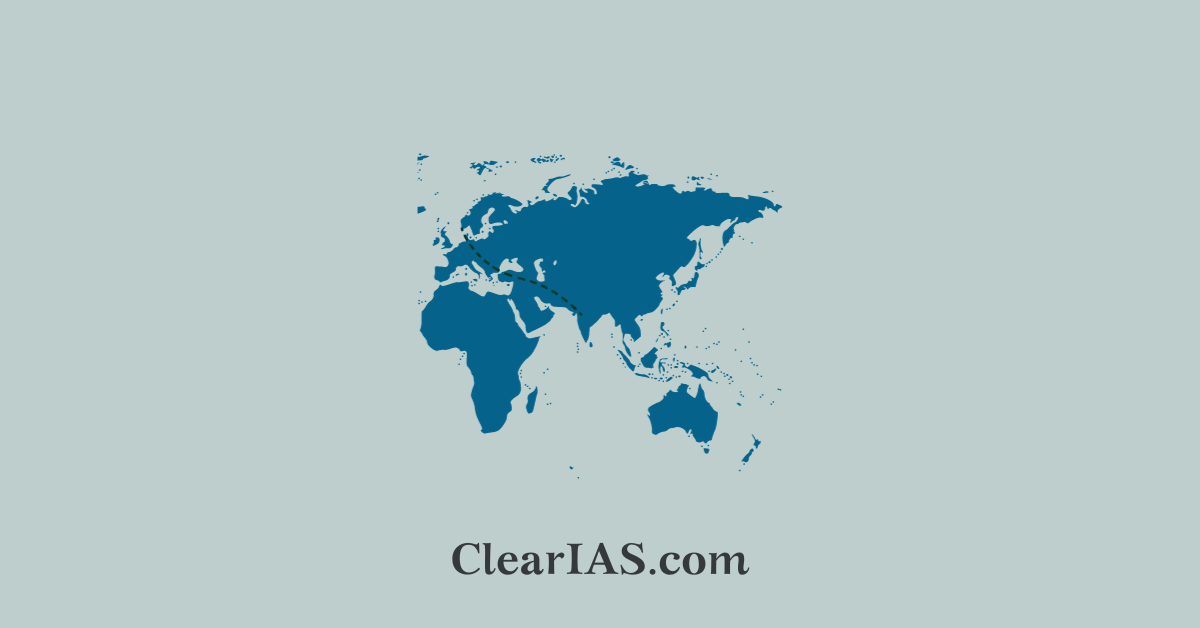
The International North–South Transport Corridor (INSTC) is the ship, rail, and road route for moving freight between India, Russia, Iran, Europe, and Central Asia. The primary goal of INSTC is to enhance connectivity and promote trade and economic cooperation among these regions Read here to learn more about the multi-modal transportation network.
The development of the International North-South Transport Corridor is part of broader efforts to improve regional connectivity and economic integration in Eurasia.
It holds the potential to reshape trade dynamics and contribute to the economic development of the participating countries while offering alternative trade routes for global commerce.
However, its full realization depends on overcoming various logistical, political, and infrastructure challenges.
India’s ‘extended neighborhood’ and INSTC
Note: Subscribe to the ClearIAS YouTube Channel to learn more.
With the coming of the new millennium, we are seeing a protracted effort from the Central government to connect with our ‘extended neighborhood’.
- This is obvious from the Look-East-turned-Act-East policy, Link West policy, etc.
- One of the significant corners in our extended neighborhood is Central Asia, with which we aim to re-connect, with our Connect Central Asia policy, pronounced in 2012.
- Central Asia as a podium has received renewed interest after the swearing-in of the new Government. India attaining full membership in the Shanghai Co-operation Organisation (SCO), PM Modi’s historic visit to the five Central Asian countries, etc. stand testimony to this.
- INSTC, or International North-South Transport Corridor, receives special mention in India-Central Asia relations.
What is INSTC?
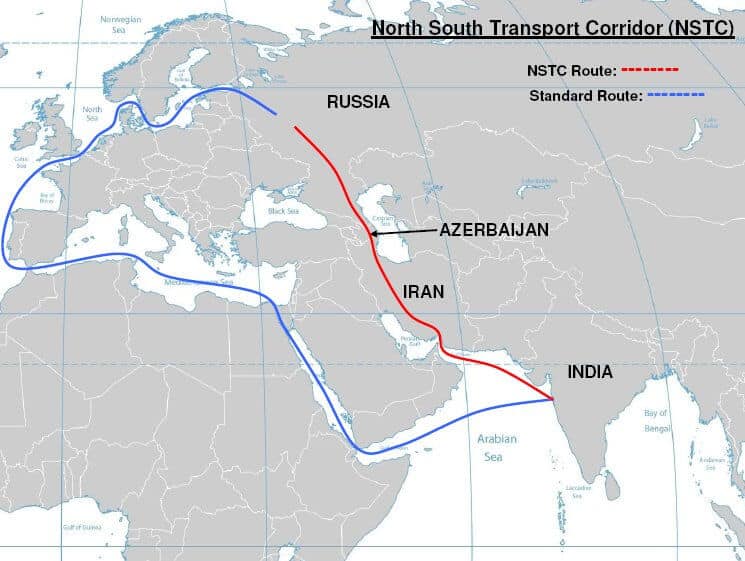
The International North–South Transport Corridor (INSTC) is a multi-modal connectivity project that establishes transport networks (ship, rail, and road route) for moving freight between India, Russia, Iran, Europe, and Central Asia.
- The INSTC is designed to provide an alternative and shorter trade route between South Asia and Northern Europe. It connects the Indian Ocean and the Persian Gulf to the Caspian Sea and further extends to Northern and Western Europe.
- It is not a new concept. This ancient route was used by European, Indian, and many other foreign traders to reach out to the Central Asian markets.
- During the time of the Safavid dynasty, it is estimated that around 10,000 Indian traders were spread across the empire. (Safavids were one of the most significant ruling dynasties of Persia (modern Iran) from 1501 to 1736.)
- The current INSTC project was initiated by Russia, India, and Iran in September 2000 in St. Petersburg.
- The modern-day INSTC is a multi-modal transportation route linking the Indian Ocean and Persian Gulf to the Caspian Sea via Iran, and then onwards to northern Europe via St. Petersburg in Russia.
- The route primarily involves moving freight from India, Iran, Azerbaijan, and Russia via ship, rail, and road. The objective of the corridor is to increase trade connectivity between major cities such as Mumbai, Moscow, Tehran, Baku, Bandar Abbas, Astrakhan, Bandar Anzali etc.
Members of the project:
As noted earlier, the founding members are Russia, India and Iran. But since the signing of the agreement in 2002, the progress on the route has been slow.
But on January 18, 2012, a meeting in New Delhi discussed the various modalities to take the project forward. As a follow-up, support from other Central Asian nations was sought, and now the group has been expanded.
The current members are India, Iran, Russia, Azerbaijan, Kazakhstan, Armenia, Belarus, Tajikistan, Kyrgyzstan, Oman, Syria, Turkey, Ukraine, and Bulgaria (observer).
Turkmenistan currently is not a formal member but is likely to have road connectivity to the corridor, after being formally invited by PM Modi.
Azerbaijan and Armenia are heavily involved in the project with both countries currently building new train lines and roads to complete the missing links in the NSTC.
The INSTC Route
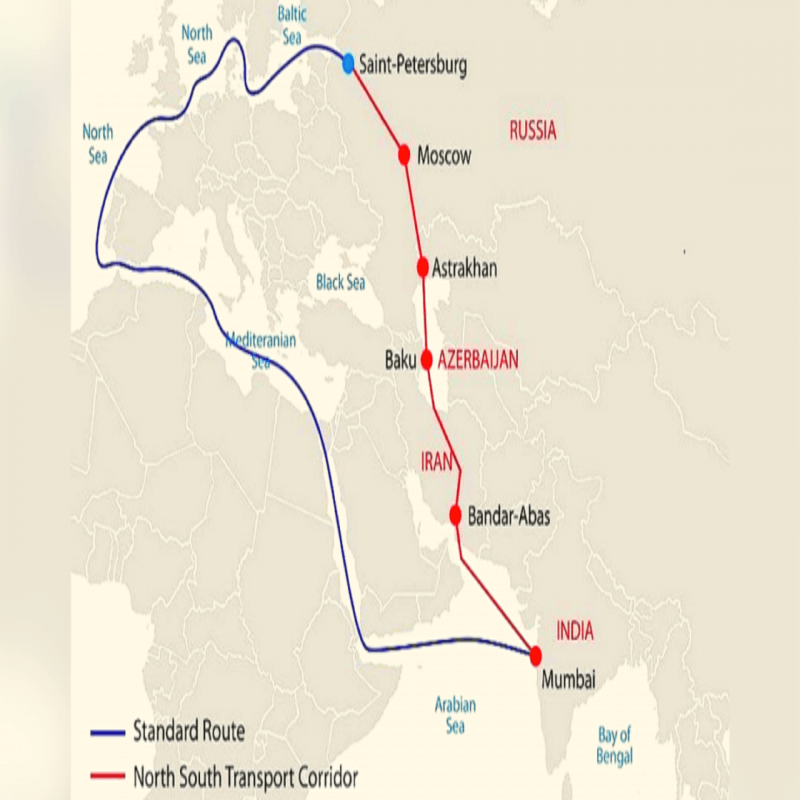
- Mumbai is at the southern hub of the route.
- The route extends to Bandar Abbas in Iran via sea. Bandar Abbas is a sprawling port city on the southern coast of Iran, on the Persian Gulf. It occupies a strategic position on the narrow Strait of Hormuz.
- From Bandar Abbas to Bandar-e-Anzali by road on the Iranian mainland. Bandar-e-Anzali is another Iranian port but on the Caspian Sea side.
- From Bandar-e-Anzali to Astrakhan by ship across the Caspian Sea. Astrakhan is a Caspian port in the Russian Federation. The city lies on the two banks of the Volga River.
- From Astrakhan to other regions of the Russian Federation, and further into Europe by Russian Railways.
Additional Routes
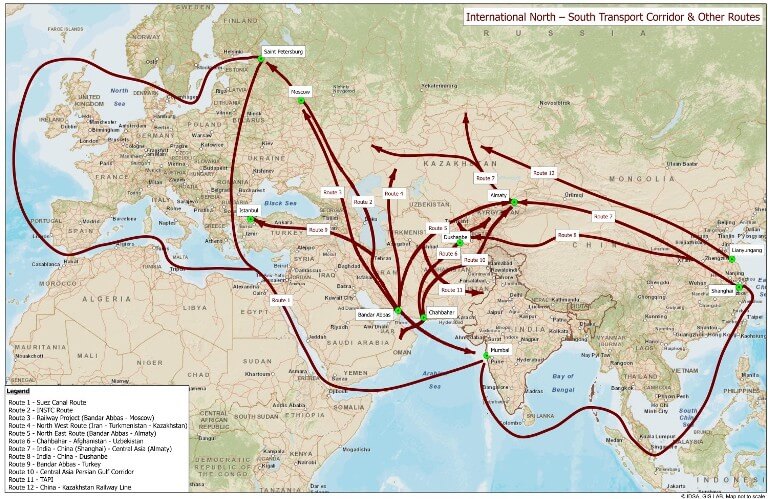
- Azerbaijan route: The NSTC route through Azerbaijan allows India-Iran-Azerbaijan-Russia-Kazakhstan transport connectivity. Iran started construction work to complete the missing link of the Qazvin-Rasht-Astara railway
- Chabahar NSTC Integration: India and Iran have a long-standing agreement, signed in 2002, to develop Chabahar port into a full deep sea port. Bandar Abbas port handles 85% of Iran’s seaborne trade and is highly congested. Whereas, Chabahar has high capacity with plans to expand it from its current capacity of 2.5 million to 12.5 million tons annually. Unlike Bandar Abbas, Chabahar can handle cargo ships bigger than 100,000 tons. Industry Analysts have highlighted there are long-term plans to integrate Chabahar with the NSTC.
- The Kazakhstan – Turkmenistan – Iran railway link: also known as North–South Transnational Corridor, is a 677 km long railway line connecting Kazakhstan and Turkmenistan with Iran and the Persian Gulf.
- Southern Armenia-Iran Railway Corridor: As the key missing link in the International North–South Transport Corridor, the Southern Armenia Railway would create the shortest transportation route from the ports of the Black Sea to the ports of the Persian Gulf.
- Trans-Iranian canal: The idea of linking the Persian Gulf and the Caspian Sea by canal was developed in the late 19th century. In 2016 Russia Today reported that the Russian and Iranian governments were discussing the project.
Objectives of the North-South Transport Corridor
As per the agreement of 2002, the main objectives of this route are:
- increasing effectiveness of transport ties to organize goods and passenger transport along the International ‘North–South’ transport corridor;
- the promotion of access to the international market through rail, road, sea, river, and air transport of the State Parties to this agreement; and
- providing security of travel and safety of goods
- harmonization of transport policies as well as law and legislative basis in the field of transport to implement this Agreement.
Advantages of the route
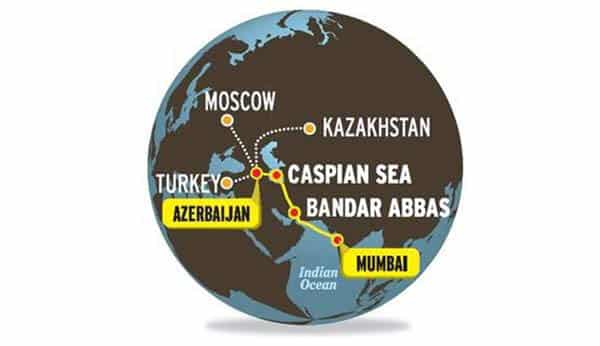
- Analysts predict by having improved transport connectivity between Russia, Central Asia, Iran, and India, their respective bilateral trade volumes will increase. The Foreign Trade Policy of India, 2015-20, has highlighted the importance of the International North-South Transport Corridor (INSTC) in expanding India’s trade and investment links with Central Asia.
- The successful activation of the corridor will help connect India to Russia within 16-21 days at competitive freight rates leading to the development of trade on the INSTC. At present, we have to either use the Rotterdam port or land route via China to reach Russia and Central Asia. These are long, expensive, and time-consuming.
- It is also expected to eliminate the usage of reefer containers for agro commodities and further support the supplies to Russia.
- A study conducted by the Federation of Freight Forwarders’ Associations in India found the route is, “30% cheaper and 40% shorter than the current traditional route”.
- For India, we can have access to the lucrative markets of Central Asia, by-passing the transit through Pakistan. Indian exports could potentially get a competitive advantage due to lower costs and less delivery time.
- The INSTC has particular economic and strategic relevance to India given the increasing regional ambitions of China through its One Belt, One Road Initiative. The proposed INSTC trade corridor could help India secure its interests in Central Asia and beyond.
- The potential of this route is manifold if India can bring on board its South East Asian neighbors too. The Suez Canal route takes 45-60 days, whereas the INSTC would take 25-30 days. Turkey has offered to provide the necessary information for linking the Black Sea Economic Cooperation (BSEC) with INSTC.
Constraints
The successful implementation of the INSTC faces challenges such as geopolitical issues, infrastructure development, customs procedures, and political cooperation among participating countries.
- INSTC still doesn’t have a strong institutional mechanism to deal with the operational issues on the ground.
- Problems related to customs procedures and documentation remain.
- Issues relating to the funding of the infrastructure needed.
- Low level of existing containerization on the route.
- Lack of common border crossing rules among the participating nations.
- Higher tariff by rail vis-à-vis road transport relating to movement from Bandar Abbas.
- Wagon shortages.
- Security problems emanating from Islamic insurgents east, and west of the route, and the associated hurdle of high insurance costs.
Current Status
To understand the problem areas and to realize the full potential of the corridor, the dry run was conducted on the Nhava Sheva–Bandar Abbas (Iran)–Baku (Azerbaijan) and the Nhava Sheva–Bandar Abbas–Amirabad (Iran)–Astrakhan (Russia) route via the Caspian Sea in August 2014 by the Federation of Freight Forwarders Associations in India (FAI).
- The dry run report points out that “the proposed INSTC route via Bandar Abbas in Iran to Russia and CIS Destination in transit through Iran, could be the best route with optimal transit/cost for the Indian exporters/importers”.
The Ukraine war has prompted Russia to refocus attention on the INSTC. The Iranian government has also renewed its commitment to it.
The 2021 blockage of the Suez Canal has further served to highlight the INSTC as a necessary if not better alternative to the Canal.
Conclusion
INSTC is an ideal start to project India as a big global player. Even though the investment is well worth it with its economic, political, and geo-strategic benefits, it is testing India’s financial backbone. India can do well to rope in other interested parties for partnering in the project, like Japan which also sees Central Asia as a lucrative market for its products.
Read:
Article by: Jishnu J Raju





It will help the aspirants to get clear idea to crack the civil service exams.it acts as a guru to show the right way to aspirants.
Sir. You are doing great work for all aspirants. Please provide a pdf file of important events of last one year for quick revision before prelims 2016.
We didn’t expect such a little mistakes as you written neighborhood instead of neighbourhood.
Hi Avi, ‘neighbourhood’ is Commonwealth English and ‘neighborhood’ is American English. As American English is the default in our platform, you may sometimes see these sort of spellings, but in the online age this is common usage.
Sir, May I know the Profile ie. background of who is Jishnu J Raju who has written the article.
currently an IAS officer
Useful article thank you